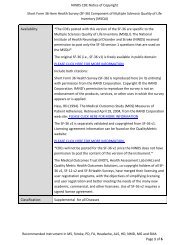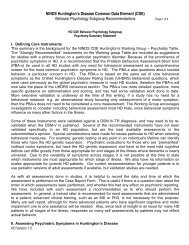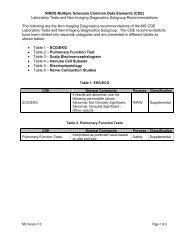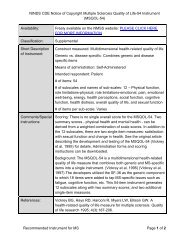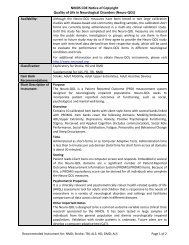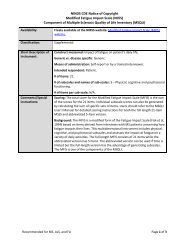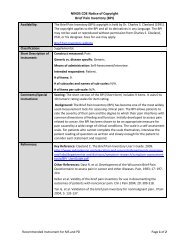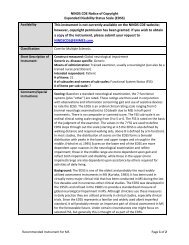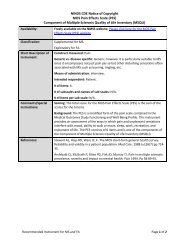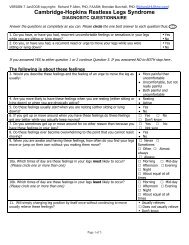National Eye Institute Visual Functioning Questionnaire - 25 item
National Eye Institute Visual Functioning Questionnaire - 25 item
National Eye Institute Visual Functioning Questionnaire - 25 item
Create successful ePaper yourself
Turn your PDF publications into a flip-book with our unique Google optimized e-Paper software.
NINDS CDE Notice of Copyright<br />
<strong>National</strong> <strong>Eye</strong> <strong>Institute</strong> <strong>25</strong> Item <strong>Visual</strong> <strong>Functioning</strong> <strong>Questionnaire</strong> (NEI-VFQ-<strong>25</strong>)<br />
Availability:<br />
Classification:<br />
Short Description of<br />
Instrument:<br />
Comments/Special<br />
instructions:<br />
Publically available. Can be obtained from the NEI Website: Please click here<br />
for the <strong>National</strong> <strong>Eye</strong> <strong>Institute</strong> <strong>25</strong> Item <strong>Visual</strong> <strong>Functioning</strong> <strong>Questionnaire</strong>.<br />
Users should also cite the following article:<br />
Development of the <strong>25</strong>-<strong>item</strong> <strong>National</strong> <strong>Eye</strong> <strong>Institute</strong> <strong>Visual</strong> Function<br />
<strong>Questionnaire</strong> (VFQ-<strong>25</strong>) — 2001 Mangione, C. M., Lee, P. P., Gutierrez, P. R.,<br />
Spritzer, K., Berry, S., & Hays, R. D. Archives of Ophthalmology, 119, 1050-1058.<br />
Supplemental.<br />
Construct measured: Dimensions of self-reported vision-targeted health status.<br />
Generic vs. disease specific: Generic.<br />
Means of administration: Interview or Self-Assessment.<br />
Intended respondent: Patient.<br />
# of <strong>item</strong>s: 28.<br />
# of subscales and names of sub-scales: 10 – General health, general vision,<br />
expectations, well-being/distress, ocular pain, near vision, distance vision,<br />
peripheral vision, social fx, color vision.<br />
# of <strong>item</strong>s per sub-scale: General health (2 <strong>item</strong>s), General vision (2 <strong>item</strong>s),<br />
Expectations (4 <strong>item</strong>s), Well-being/distress (4 <strong>item</strong>s), Ocular pain (2 <strong>item</strong>s),<br />
Near vision (7 <strong>item</strong>s), Distance vision (4 <strong>item</strong>s), Peripheral vision (1 <strong>item</strong>), Social<br />
function (1 <strong>item</strong>), Color vision (1 <strong>item</strong>).<br />
Background: The <strong>National</strong> <strong>Eye</strong> <strong>Institute</strong> (NEI) sponsored the development of the<br />
VFQ-<strong>25</strong> with the goal of creating a survey that would measure the dimensions<br />
of self-reported vision-targeted health status that are most important for<br />
persons who have chronic eye diseases. Because of this goal, the survey<br />
measures the influence of visual disability and visual symptoms on generic<br />
health domains such as emotional well-being and social functioning, in addition<br />
to task-oriented domains related to daily visual functioning. Questions included<br />
in the VFQ-<strong>25</strong> represent the content identified during a series of conditionspecific<br />
focus groups with patients who had age-related cataracts, glaucoma,<br />
age-related macular degeneration, diabetic retinopathy, or CMV retinitis.<br />
Recommended Instrument for MS Page 1 of 2
NINDS CDE Notice of Copyright<br />
<strong>National</strong> <strong>Eye</strong> <strong>Institute</strong> <strong>25</strong> Item <strong>Visual</strong> <strong>Functioning</strong> <strong>Questionnaire</strong> (NEI-VFQ-<strong>25</strong>)<br />
Scoring:<br />
References:<br />
Rationale/<br />
Justification:<br />
First, original numeric values from the survey are re-coded following the scoring<br />
rules outlined in the manual. All <strong>item</strong>s are scored so that a high score<br />
represents better functioning. Each <strong>item</strong> is then converted to a 0 to 100 scale so<br />
that the lowest and highest possible scores are set at 0 and 100 points,<br />
respectively. In this format scores represent the achieved percentage of the<br />
total possible score, e.g. a score of 50 represents 50% of the highest possible<br />
score. In step 2, <strong>item</strong>s within each sub-scale are averaged together to create<br />
the 12 sub-scale scores. Items that are left blank (missing data) are not taken<br />
into account when calculating the scale scores. Sub-scales with at least one<br />
<strong>item</strong> answered can be used to generate a sub-scale score. Hence, scores<br />
represent the average for all <strong>item</strong>s in the subscale that the respondent<br />
answered.<br />
To calculate an overall composite score for the VFQ-<strong>25</strong>, simply average the<br />
vision-targeted subscale scores, excluding the general health rating question. By<br />
averaging the sub-scale scores rather than the individual <strong>item</strong>s we have given<br />
equal weight to each sub-scale, whereas averaging the <strong>item</strong>s would give more<br />
weight to scales with more <strong>item</strong>s.<br />
Mangione CM, et al. Development of the <strong>25</strong>-<strong>item</strong> <strong>National</strong> <strong>Eye</strong> <strong>Institute</strong> visual<br />
Function <strong>Questionnaire</strong>. Arch Ophthalmol. 2001 Jul;119(7): 1050-1058.<br />
Strengths/Weaknesses: The questionaire has never been validated in multiple<br />
sclerosis patients.<br />
Psychometric Properties: Estimates of internal consistency indicate that the<br />
subscales of the NEI VFQ-<strong>25</strong> are reliable. The validity of the NEI VFQ-<strong>25</strong> is<br />
supported by high correlations between the short- and long-form versions of<br />
the measure, observed between-group differences in scores for persons with<br />
different eye diseases of varying severity, and the moderate-to-high<br />
correlations between the NEI VFQ-<strong>25</strong> subscales that have the most to do with<br />
central vision and measured visual acuity.<br />
Administration: The VFQ-<strong>25</strong> takes approximately 10 minutes on average to<br />
administer in the interviewer format. There is also a self-administered version<br />
of the survey, however, psychometric testing of the self-administered version<br />
has not been done. Self-administered in the majority of patients. May require<br />
assistance from trained interviewers in patients with cognitive deficits and<br />
patients with severe visual impairment.<br />
Recommended Instrument for MS Page 2 of 2



